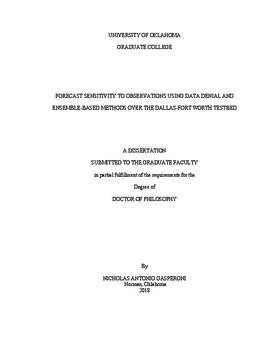| dc.description.abstract | The ‘Nationwide Network of Networks’ (NNoN) concept was introduced by the National Research Council to address the growing need for a national mesoscale observing system. Part of this growing need is the continued advancement toward accurate high-resolution numerical weather prediction. The research testbed known as the Dallas – Fort Worth (DFW) Urban Demonstration Network was created to experiment with many kinds of mesoscale observations that could be used in a data assimilation system, in order to identify observational systems that are most impactful on high-resolution forecasts. Many observation systems have been implemented for the DFW testbed, including Earth Networks (ERNET) Weather Bug surface stations, Citizen Weather Observer Program (CWOP) amateur surface stations, Global Science and Technology (GST) mobile truck observations, CASA X- band radars, SODARs, and radiometers. These ‘nonconventional’ observations are combined with conventional operational data from METARs, mesonet, aircraft, rawinsondes, profilers, and operational radars to form the testbed network. A principal component of the NNoN effort is the quantification of observation impact from several different sources of information. This dissertation covers two main themes related to quantifying the impact that observations have on forecasts.
The first part is the quantification of impact using data denial experiments, or observational simulation experiments. The GSI-based EnKF data assimilation system was used together with the WRF-ARW model to examine impacts of observations assimilated for forecasting convection initiation (CI) in the 3 April 2014 hailstorm case.
Data denial experiments were conducted testing the impact of high-frequency (5-min) assimilation of nonconventional data on the timing and location of CI, as well as on the development of storms as they progress through the testbed domain. Results using ensemble probability of reflectivity and neighborhood ensemble probability of hail show nonconventional observations were necessary to capture local details in the dryline structure causing localized enhanced convergence and leading to CI. Diagnosis of denial-minus-control fields showed the cumulative influence each observing network had on the resulting CI forecast. It was found that most of this impact came from the assimilation of thermodynamic observations. Accurate metadata is found to be crucial to the application of nonconventional observations in high-resolution assimilation and forecasts systems.
The second part of this dissertation explored the application of the ensemble- based forecast sensitivity to observations (EFSO). First, tests using a global two-layer model were performed to identify areas of improvement in the localization methods needed to make EFSO estimates accurate. Due to the time-forecast component, localization of the EFSO metric is more complicated than during traditional assimilation because as forecast time increases the error correlation structures evolve with the flow. Experiments made use of the local ensemble transform Kalman filter (LETKF) with a simple two-layer primitive equation model and simulated observations. Application of an adaptive localization method – regression confidence factors (RCF) based on a Monte Carlo “group filter” technique – led to marked improvement especially for longer forecasts and at midlatitudes, when systematically verified against actual impact in RMSE and skill scores.
Results showed that the shape,location, time-dependency, and variable-dependency of RCF localization functions are consistent with underlying dynamical processes of the model. The impact estimates near the equator were not as effective due to large discrepancies between the RCF function and the localization used at assimilation time. These latter results indicated that there exists an inherent relationship between the localization applied during the assimilation time and the proper localization choice for observation impact estimates. Application of RCF for automatically tuned localization is introduced and tested for a single observation experiment.
Next, the EFSO method was applied to the high-resolution CI case from 3 April 2014 and evaluated for accuracy in terms of several verification metrics, including energy norms surface variables, and composite reflectivity. Static and advected localization were applied to EFSO and compared for accuracy to the actual forecast error reduction. The RCF method was also applied to the convective-scale EFSO estimation. Results showed that different verification metrics lead to different forecast length scales of useful estimates. The application of EFSO to reflectivity is hindered by the high nonlinearity of convection, though there were some qualitative insights in its use. The application of RCF localization, while found to reveal the underlying flow- dependence of the case study including the time-forecast component, did not improve upon the advected localization method. This is hypothesized to be due in part to insights gained from the two-layer model work, though other adaptive methods may yet yield better results. Nevertheless, the application of EFSO is appropriate for convective-scale systems on forecast time scales of 90 minutes or less. | en_US |
